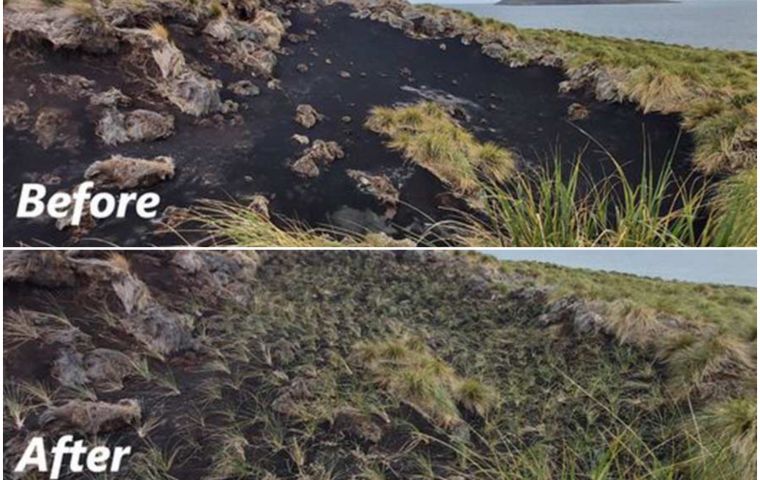MercoPress. South Atlantic News Agency
Falklands government and NGOs restores tussac peatland on nature reserves
 The two pictures show the eroded soil at Gid’s and Middle Islands, before and after the four day planting of 17,000 tussac tillers Photo Credit to Sally Poncet.
The two pictures show the eroded soil at Gid’s and Middle Islands, before and after the four day planting of 17,000 tussac tillers Photo Credit to Sally Poncet. The Environment Department of the Falkland Islands Government has announced a successful tussac planting campaign at Gid’s and Middle Islands this winter in collaboration with Island LandCare and the Antarctic Research Trust.
Gid’s and Middle Islands are two uninhabited nature reserves located in the remote King George Bay on West Falkland. Native tussac grassland on the two islands had become patchy, with large areas of black peaty soil that was eroding away. Planting tussac was the best way to stabilize the soil and fill in the areas where tussac used to grow. As part of FIG’s ambition to restore biodiversity in its nature reserves, a team was contracted to plant tussac on the two islands.
In May 2023, Sally Poncet and Ken Passfield from Island LandCare led an experienced team for an intense four-day tussac planting campaign. Joining them were Simon Browning, Chris Hawksworth, Jeremy Poncet and Mauricio Ruiz.
The team spent two days on Gid’s Island and two days on Middle Island, travelling daily from nearby Hummock Island, where they were based. They made the most of their limited daylight hours and planted a total of 17,000 tussac tillers over the four days. Averaging over 700 tussac tillers per person per day, it was an astonishing feat of hard work and dedication.
Sally explains why tussac is perfect for restoration: “When the tillers take root, they will help to stabilize the black peaty soil. They will provide protection from the wind and help to retain soil moisture. Planting densely reduces the chance that non-native species such as sheep's sorrel and Yorkshire fog are able to become established and out-compete the tussac. They are also likely to grow rapidly enough to be used as a source of tillers for future restoration work.”
“We have a responsibility to look after our natural heritage,” says Rachel Cooper from the FIG Environment Department. “Gid’s and Middle Islands were ideal locations for restoration, both are owned by FIG and Middle Island is a protected reserve. Our habitat work will be ongoing so we look forward to achieving a lot more.”




Top Comments
Disclaimer & comment rulesCommenting for this story is now closed.
If you have a Facebook account, become a fan and comment on our Facebook Page!